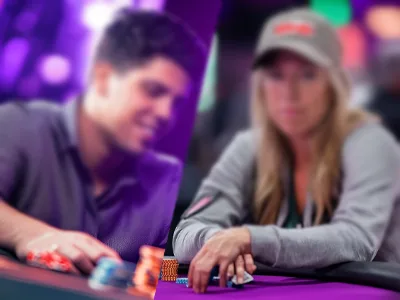There has been a lot of discussion about a recent $25/50 high-stakes poker hand, played by YouTuber Mariano and tournament crusher Kristen Foxen, in which both players flopped monster holdings on a KQJ rainbow board.
Mariano, who raised from UTG+1, flopped the nuts with ATo. Foxen, who called from the big blind after four other players also called, flopped the second nuts with T9o.
Most of the conversation on social media has focused on either Mariano’s luck or the sickness of such a cooler, but I haven’t seen much discussion about two particular perspectives that might go against the grain. Let’s take a look.
To Slowplay Or Not To Slowplay
The hand begins with Mariano c-betting his nutted hand for a quarter pot ($600) into five players. With two callers in tow, Foxen check-raises to 4.5x the bet, which only Mariano calls.
The first question worth asking is whether Mariano really needs to flat the check-raise. Admittedly, it’s easy to play armchair quarterback with hole cards exposed, and flatting a check-raise in position with the nuts is certainly the standard approach. Still, putting ourself in Mariano’s shoes, it’s fair to ask what part of Foxen’s range would raise this flop and then fold to a non-all-in raise (both players started the hand deep, with $32,000 effective).
Foxen is almost certainly never folding value hands—sets, two pairs, straights. Even her semi-bluffs, if she has any here, would often continue given a reasonable price. And since the hand started multi-way, with Foxen check-raising into four remaining players, it’s unlikely she’s doing it with pure air very often, if ever.
So yes, Mariano flatting keeps her full range in and, perhaps more importantly, allows the two remaining players to call behind, but given that neither had shown much strength to this point, the chances of them continuing also have to be discounted somewhat. In my mind, the bigger risk in slow playing is missing oodles of value.
When we flop the nuts against a strong range, there is often more merit in piling chips into the pot immediately. Any board-pairing card, as well as an ace or ten, changes the dynamics of the hand by either reducing the value of AT or by causing the opponent to slow down and killing our ability to extract max value.
As it turns out, that’s exactly what happened, with the turn bringing another king and giving both players reason to pause.
Understanding the changed dynamics, Foxen now elected to check and called Mariano’s half pot bet.
As wild as it seems to rethink a hand that was so strong just a moment earlier, it becomes important to ask ourself what we now actually beat. Mariano c-bet into multiple players, called a check-raise, and then barrelled the turn after the board paired. Most of the hands that were behind on the flop have either improved to full houses or no longer have reason to bet. Sets like JJ, QQ, and KK now have you drawing dead. Two-pair hands like KQ and KJ are also full houses.
Things are made worse by the fact Foxen holds both a ten and a nine, blocking Tx bluffs, as well as two of the few value hands she still beats with KT and the relatively unlikely K9s.
With all that in mind and knowing that floating light and firing again after the board pairs is a low probability line, Mariano is left representing only a few weaker value hands—mainly AK and AA, the latter of which might very well check back the turn to avoid risking get check-raised again.
After Foxen calls the turn and the river bricks out with an offsuit deuce, the second major decision point arrives.
Value Hand or Bluff-Catcher?
After Foxen checks the river, Mariano bets again for about 40% pot—very sharp sizing that shows he understands exactly where he and his opponent are in the hand and what he can realistically get called by.
At this point, Foxen’s T9o is a far ways from the second nuts it started out as. Going through the “what can I beat?” checklist, it begins looking much closer to a bluff-catcher than a value hand. Regardless of the absolute strength of T9 on the flop, its relative strength has to be considered once the board and betting action have fully developed.
And generally speaking, against a range heavy on value and light on bluffs, the value of our bluff-catchers craters. Without a strong read that Mariano is over-bluffing in this particular spot, calling off here edges towards a low-expectation decision.
So What Can We Apply to Our Game?
This hand is a good example of two related ideas. First, when you flop a hand at the top of your range against a relatively strong range, there is often more risk in letting future cards come than there is in forcing the action immediately. Second, even very strong hands can lose their absolute strength quickly when board texture and betting lines shift the value-to-bluff ratio heavily in one direction.
It’s no doubt easy to second guess when seeing the cards face up. This isn’t to say that Foxen should have folded, or even to imply that I would have in-game (especially not versus Mariano’s perfect river sizing). It’s simply a reminder that we have to train ourselves to break down our opponents’ ranges hand by hand and recognize that not all value hands are created equal.
But hey, if you see it differently and think I’m wrong, leave me a comment below and let me know how.


